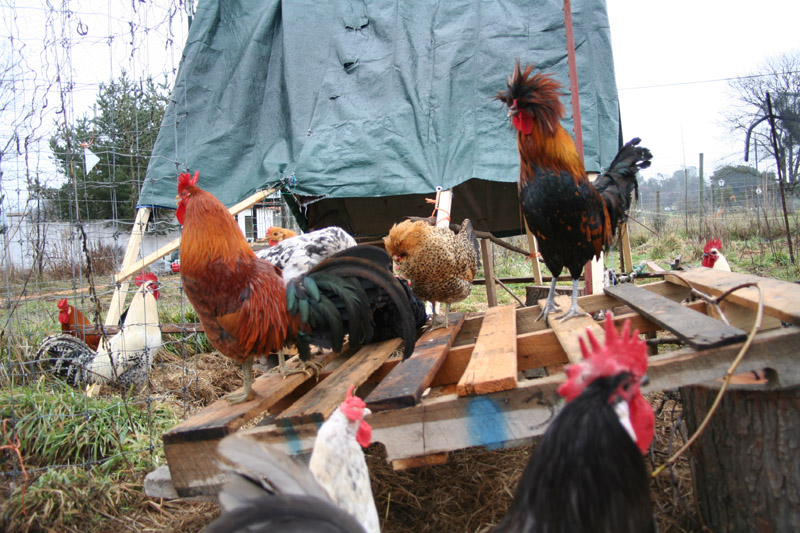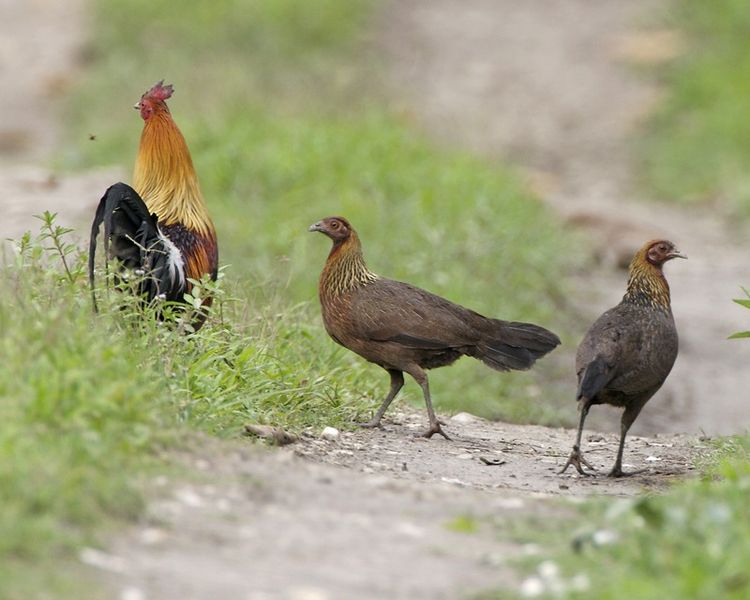This page just is to point out that very well can matter a great deal which chicken breed you get. I recommend to do your research, find out what you want and THEN find a place, breeder or hatchery to get what you are looking for….unless you just want some chickens from a the local farm store – in which case you probably would not be reading this 🙂

Does it really matter what kind of chicken we get? A chicken is a chicken – right?
Nope, nothing could be further from the truth – on more than 1 account. Not only have individual chickens a distinct personality, the various chicken breeds also have varying characteristics, from size, color, temperament to egg laying, weather tolerance, foraging interest and more.
Q: What chickens should you get? A: The kind that fits your purpose and climate.
You want eggs only: ->Egg layer
Eggs and meat: ->dual purpose
Meat: -> meat birds
Show: -> pick healthy birds from good breeders.
Amongst those will be good foragers and watch dogs – or not, heat or cold tolerant varieties, some especially docile, some with a tendency to go broody and of course available time and space, especially space are some of the attributes to consider.
First off find out if you can have roosters where you live!!!!! Also find out what the specifics are in terms of keeping any chickens at all. I can’t stress this enough.
I live in a fully AG zoned area and still had trouble because of roosters.
The following is my personal experience – and I have been very happy with the birds I got – from Sandhill Preservation Center.
I will review the chicken breeds I have experience with – this will be with hens as well as roosters.
Here is why I have roosters: My chicks were obtained as day olds from Sandhill Preservation. They were recommended to me and I trusted the source. Sandhill only ships straight runs, meaning they don’t sex, that is, they don’t determine the sex of the chicken.
I wanted: egg layers or dual purpose ( no meat birds), heat tolerant and good foragers, non broody.
My first batch were 4 different breeds of assorted light chickens. Light chickens are typically egg layers.
In May, I got 5 Egyptian Fayoumis, 6 Sicilian Buttercups, 11 Blue Andalusians and 4 Golden Polish.
My second batch, in September, were:
20 Buff Catalanas and & 7 Buff Minorcas
Of the assorted first batch of 26 chicks, 17 turned out male – 9 were female – Luck of the draw.
The Buffs: 12 female and 15 male.
Grant total of the 2 batches that year: 21 pullets and 32 cockerels.
That was tough, but it had a real good upside: I got a LOT of experience with roosters.
The breeds I got are not your usual variety I found out. So I thought I’ll review from the actual experience I have had with them. (pages coming soon)
- Egyptian Fayoumi
- Buttercup
- Blue Andalusian
- Golden Polish
- Buff Catalana
Before that, here is some information on
Where the original Chickens came from:
The Red Junglefowl (Gallus gallus) is a tropical member of the Pheasant family. It is thought to be ancestral to the domestic chicken, with some hybridisation with the Grey Junglefowl. The Red Junglefowl was first domesticated at least five thousand years ago in Asia, then taken around the world, and the domestic form is kept globally as a very productive food source of both meat and eggs.
photo from wikipedia The associations between individuals in a free-living population of red junglefowl are visualised in a cluster analysis. The flock structure is shown for the population when females are with and without chicks, and the differences described. Various kinds of groupings are present, from solitary individuals to mixed-sex flocks. The strongest associations maintaining flock cohesion are shown to be female-female pairings and it is these which break down when the females produce their chicks. *Department of Wildlife Sciences, Centre of Wildlife & Ornithology, Aligarh Muslim University, Aligarh 202 002, India, **Bombay Natural History Society, S.B. Singh Road, Mumbai 400 023, India
Abstract: The habitat use and flock composition of the Red Junglefowl Gallus gallus in Dudwa National Park, India was studied between 1991 and 1994. Six habitats were monitored during winter and summer throughout the study period. Data on habitat use, flock size and flock composition were collected from monitoring of six line transects and regular sightings along the road. Bonferroni simultaneous confidence interval was constructed to determine ha-bitat use by Red Junglefowl. It showed preference for mixed forest and showed avoidance for teak forest. A total of 1174 individuals were seen more in summer, especially females. Maxi-mum flock size was observed in sal forest in winter 1992. More than 80% (n=465) of the total observations were of single bird. The Red Junglefowl though not threatened and a species of less concern, needs continuous monitoring and proper management inputs so that it does not follow the fate of some other pheasant species. one of the available studies of these ancesters of chickens: http://www.tropecol.com/
 In that study mentioned: most sighting were of single birds …80 %, male of female – except around breeding times. also, while there were generally more females, that twas not always the case. – i am just wondering where this: “there needs to be 8-10 hens for every rooster” is coming from ….maybe, if you have enough space ……just questioning something. of course, those roosters there don’t have to live together in a coop, and then with the hens….. interesting too that most images of red jungle fowl are of solitary birds or pairs. I have been wondering for some time what happens to all the roosters of the original chickens….. since we seem to have to get rid of so many….
In that study mentioned: most sighting were of single birds …80 %, male of female – except around breeding times. also, while there were generally more females, that twas not always the case. – i am just wondering where this: “there needs to be 8-10 hens for every rooster” is coming from ….maybe, if you have enough space ……just questioning something. of course, those roosters there don’t have to live together in a coop, and then with the hens….. interesting too that most images of red jungle fowl are of solitary birds or pairs. I have been wondering for some time what happens to all the roosters of the original chickens….. since we seem to have to get rid of so many….
